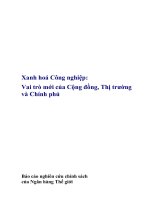110-LuanVanThacSi-ChuaPhanLoai (198).pdf
Bạn đang xem bản rút gọn của tài liệu. Xem và tải ngay bản đầy đủ của tài liệu tại đây (17.22 KB, 3 trang )
INFORMATION ON MASTER’THESIS
1. Full name:
Truong Ba Kien
2. Sex: Male
3. Date of birth:
10/7/1986
4. Place of birth: Phutho Province
5. Admission decision number:
Dated
6. Changes in academic process:
7. Official thesis title:
Study effects of atmospheric-ocean interaction on track and intensity of tropical
storms by HWRF model.
8. Major: Meteorology and Climatology
9. Code: 60.44.87
10. Supervisors: Dr. Hoang Duc Cuong - Institute of Meteorology, Hydrology and
Environment - Ministry of Natural Resources and Environment.
11. Summary of the finding of the thesis:
Overview the research of atmospheric-ocean interaction on track and
intensity of tropical storm on the world and in Viet Nam: Ooyama (1969), Chang
and Anthes (1979) showed that a significant weakening of the storm when it moves
through the cold water. Kerry Emanuel (1986) combinated theory and simple
model to stuy atmospheric-ocean interaction on tropical storm. He showed that role
and effects of heat and moisture flux of ocean on tropical storm. Kerry Emanuel and
Lars R.Schade (1998) used coupled atmosphere-ocean model to study storm. They
showed that conditions of ocean affect on intensity of storm. The SST feedback
effect can reduce storm’s intensity with rapid moving typhoon and it is seem that no
effect on slow moving storm. Wiexing, I.Ginis (2003) studied on effect of heat flux
from ocean though SST on changing intensity of tropical storm at shadow water.
They showed that SST have an strong influence on storm’s intensity. Chau-Ron Wu
et al (2008) study intercation of tropical storm Nari with Kuroshio current when it
move in to this current . They indicated that storm weak when it move though cold
water and powerful intensity when it move though warm water during storm’s exist.
Yalinfan et al (2009) studied on effects of wawes on exchanging flux between
atmosphere and ocean when tropical storm happens. They showed that interactions
between currents and wawes on flux making storm being weaked. Liu et al (2010)
used coupled atmosphere-ocean-wave model system (WRF-POM-SWAN)
to
simulate intensity of storm and showed that: the atmosphere-wave relation
strengthen intensity, in contrast, dynamical atmosphere-ocean relation weaken
storms. Total effect on intensity are determinated by postive feedback of wave and
negative feedback of SST. If storms move through cold water, it will be weaked.
Storms make areas where they move being colder. In Vietnam: Le Dinh Quang
Quang (2000) studied effects of SST on tropical cyclone which being formed or
moved to the EastSea. They showed roles and effects of SST on track and intensity
of tropical cyclones. In generally, there is a lack of research on effects of
atmosphere-ocean interaction on track and intensity of storm and those effects have
not been fully understood.
A coupled atmosphere-ocean model system which is called WRF-ROMS has
built. Three tropical storms, which are Mindulle (2010), Nock-ten and Nalgae
(2011) with coupled and uncoupled (control case) atmosphere-ocean models, were
studied. The results show that:
The SST in coupled case are lower than the SST in control case about 230C at initial time, increasing by 3-40 C for 24h-term forecast, by 4-50 C for 72h
-term forecast.
The pressure at sea level of couplde case are higher than one in control case
about 2-3 mb for 12h-term forecast, increase by 6-8 mb for 24h-term forecast,
increasing rapidly for 48h and 72h-term forecast corresponding approximately 1415 mb and 22-24 mb.
The averaged wind speed at surface of couple case is weaker than one in
control case.
The heat-moisture flux in couple case is lower than one in control case.
In two cases, simulated storms moved faster than observated ones. The
cross track error of couple case are lower than one in control case. In the coupled
case, simulated storms is more left than observated ones. In the control case,
simulated storms is more right than observated ones .
The Slpmin in the control case is higher than the Slpmin in the observation
for 12h-term forecast. For other term, slpmin is lower than slpmin in the
observation. SST is continously updated every ten minutes from ROMS model on
the WRF model, causing the SST in the coupled case is lower than the SST in the
uncoupled case (SST is automatically used from Global Forecast Model - GFF).
Similar to surface wind, air pressure and heat-moisture flux in the coupled case are
lower than ones in the control case.
In conclusion, storm intensity in the coupled case is lower than storm
intensity in the uncoupled case.
12. Practical applicability: The study is highly practical and can be applied for
storm forecast in Vietnam.
13. Further research directions: study on deeply atmospheric-ocean interaction to
tropical cyclones.
14. Thesis-related publications:
Date: 07th, June, 2012
Signature:
Full name: Truong Ba Kien









